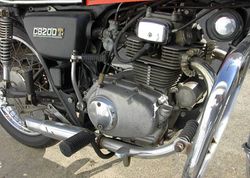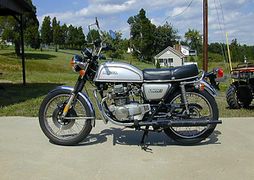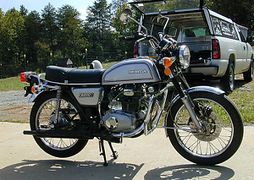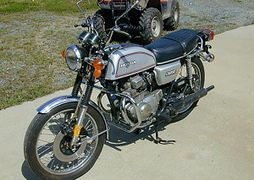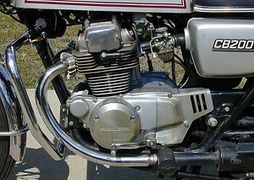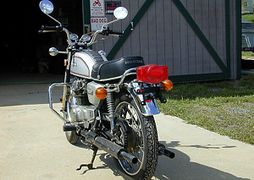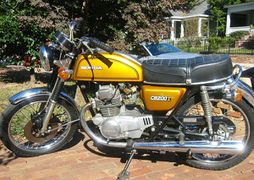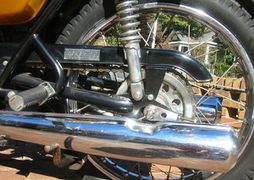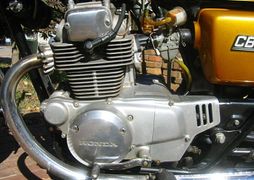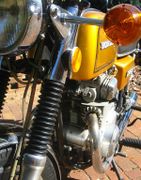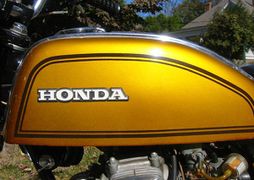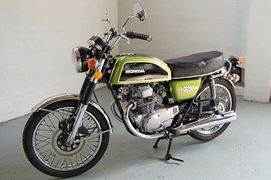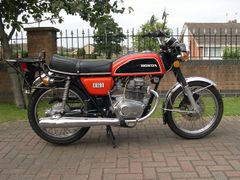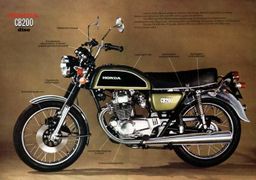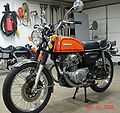Honda CB200T: review, history, specs
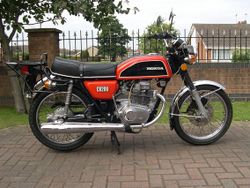 |
|
| Honda CB200 | |
| Manufacturer | |
|---|---|
| Also called | CB200 disc, CB 200 disc, CB200 Disc, CB 200 Disc, CB 200 |
| Production | 1972 - 1978 |
| Class | Classic |
| Predecessor | Honda CB175 |
| Engine | two cylinder boxer, four-stroke |
| Bore / Stroke | 55.5mm x 41.0mm |
| Compression ratio | 9.0:1 |
| Top Speed | 77 mph (124 km/h) |
| Horsepower | 16.63 HP (12.4 KW) @ 9000RPM |
| Fuel System | carburetor |
| Transmission | Gear box: 5-speed Final Drive: chain |
| Suspension | Front: telescopic fork Rear: dual shock absorbers |
| Brakes | Front: single disc Rear: expanding brake |
| Front Tire | 2.75-18 |
| Rear Tire | 3.00-18 |
| Weight | 142.0 kg (wet) |
| Recommended Oil | Honda GN4 10W-40 |
| Fuel Capacity | 2.91 Gallon (11.00 Liters) |
| Related | Honda CB125, Honda CB160, Honda CB175 |
| Manuals | Service Manual |
The Honda CB200 was a vertical two cylinder, four-stroke Classic motorcycle produced by Honda between 1972 and 1978. It could reach a top speed of 77 mph (124 km/h). Claimed horsepower was 16.63 HP (12.4 KW) @ 9000 RPM. The CB200T’s most recognizable characteristic is the "vinyl roof"-style three-inch-wide padded strip on the fuel tank’s spine.
Engine[edit | edit source]
The engine was an air cooled, vertical two cyinder four-stroke. A 55.5mm bore x 41.0mm stroke yielded a displacement of 198.0 cubic centimeters. Fuel was supplied by two carburetors. Valves were operated by a chain-driven single overhead camshaft (ohc).
Drive[edit | edit source]
The bike has a 5-speed transmission. Power was moderated via the wet plate.
Chassis[edit | edit source]
It came with a 2.75-18 front tire and a 3.00-18 rear tire. Stopping was achieved via single disc in the front and a expanding brake in the rear. The front suspension was a telescopic fork while the rear was equipped with a dual shock absorbers. The CB200 was fitted with a 2.91 Gallon (11.00 Liters) fuel tank.
1972 Honda CB 200[edit | edit source]
The 1972 MY Honda CB 200 has, at its heart, an air-cooled, four-stroke, 196cc, twin cylinder powerplant, mated to a five-speed manual transmission with a chain final drive, that can reach a maximum power output of 17 horsepower at 9.000 rpm.
Also, it has been fitted with features such as laced wheels, a dual seat, a front disc brake coupled to a rear drum brake, wide handlebars, analogue instrumentation dials, a large, round headlight, a chromed, dual exhaust system, a blacked-out, steel frame, a telescopic front fork and dual shock absorbers as a rear suspension.
1973 Honda CB 200[edit | edit source]
The 1973 MY Honda CB 200 has standard features such as laced wheels, a dual seat, a front disc brake coupled to a rear drum brake, wide handlebars, analogue instrumentation dials, a large, round headlight, a chromed, dual exhaust system, a blacked-out, steel frame, a telescopic front fork and dual shock absorbers as a rear suspension.
In the engine department it is powered by a four-stroke, air-cooled, 196cc, twin cylinder powerhouse, that was paired to a five-speed manual transmission with a chain final drive, and could produce a claimed 17 horsepower at 9.000 rpm.
1974 Honda CB200T[edit | edit source]
The 1974 MY Honda CB 200 boasts a maximum power output of 17 horsepower at 9.000 rpm from its air-cooled, four-stroke, 196cc, twin cylinder powerplant that was mated to a five-speed manual transmission with a chain final drive.
In addition, it has been fitted with laced wheels, a dual seat, a front disc brake coupled to a rear drum brake, wide handlebars, analogue instrumentation dials, a large, round headlight, a chromed, dual exhaust system, a blacked-out, steel frame, a telescopic front fork and dual shock absorbers as a rear suspension.
1976 CB200T[edit | edit source]
For the 1975 model year, the CB200T got a disc brake up front. Oddly enough, though, it was operated by a cable, rather than the near-universal hydraulic system. [1]
In Media[edit | edit source]
References[edit | edit source]
- ↑ 1975 Honda CB200T. Hemmings Daily. Retrieved on 2019-05-23.
See Also[edit | edit source]
| ||||||||||||||
